Did you know that there are over 20 different LGBTQ flags?
Each queer community has their own flags with their own meaning. These flags tell a story of the individuals and groups within the LGBTQIA+ community, represented by the various colors in stripes, shapes, and symbols.
So CARE Counseling has decided to celebrate pride month by briefly walking through the history of some of the flags, their creation, and their meanings.
The history of the Pride Flag dates all the way back to the 1970s, right after the famous Stonewall Riots in 1969. The designs we know and love have changed numerous times over the years as we all grow together as an ever-changing and evolving community. The flags have been added and changed throughout time all hold different meaning to different groups of people. But the flags all link back to the same beginning.
In 1978, activist and artist Gilbert Baker created the first rainbow flag titled The Gilbert Baker Pride Flag. Baker was challenged to create a symbol of pride for the gay community after meeting Harvey-Milk, a politician and gay rights activist. Milk become the first openly gay elected official [1977] to hold a visible position in a major US city, San Francisco. Milk’s time in office was tragically cut short after being assignation only one year later, on November 27, 1978.
The Gilbert Baker Pride Flag made its first appearance at the San Francisco Gay Freedom Day Parade on June 25, 1978.
The original draft for the first rainbow flag had eight colors, with each having a special meaning. The flag was then cut to only six colors due to the difficulty in obtaining the fabric needed for the hot pink stripe. Activists later complained that the seven stripes were too difficult to split in half to easily display in public so the turquoise stripe was also eliminated from the flag. This left us with the six-stripe flag we know and love today!
Pink represents sex. Red represents life. Orange represents healing. Yellow represents sunlight, Green represents nature, Turquoise represents magic/art, Indigo represents serenity, and Violet represents spirit. The Traditional Gay Pride Flag that is most common worldwide today includes six stripes (minus the pink and turquoise).

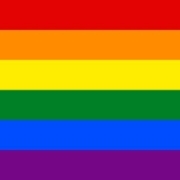
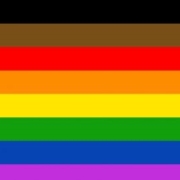
Over the years, various flags were designed to represent LGBTQ people as symbols of pride that helped provide visibility within the social movement, with the June 1969 Stonewall-Riots as a catalyst to social change in the fight against discrimination.
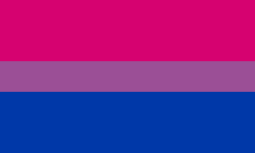 In 1998, Michael Page designed the bisexual pride flag for the community with pink, purple, and blue stripes. The pink represents same-sex attraction, the blue represents opposite-sex attraction, and the purple overlap represents attraction to both.
In 1998, Michael Page designed the bisexual pride flag for the community with pink, purple, and blue stripes. The pink represents same-sex attraction, the blue represents opposite-sex attraction, and the purple overlap represents attraction to both.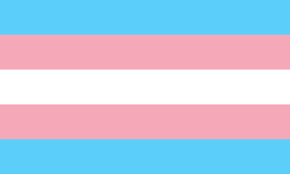 In 1999, Monica Helms (a transgender woman) created the transgender pride flag with three colors. Light pink and blue represent the colors traditionally associated with girls and boys, and white represents transitioning, neutral or undefined genders, and intersexuality. This was done because “no matter which way you fly it, it is always correct, signifying us finding correctness in our lives,” Helms said of the flag.
In 1999, Monica Helms (a transgender woman) created the transgender pride flag with three colors. Light pink and blue represent the colors traditionally associated with girls and boys, and white represents transitioning, neutral or undefined genders, and intersexuality. This was done because “no matter which way you fly it, it is always correct, signifying us finding correctness in our lives,” Helms said of the flag.
 In 2010 the Pansexual community added their own flag to the collection by posting it on Tumblr. The flag was coined by Jasper V, a queer, non-binary person living in England. The Pansexual Pride Flag’s colors are commonly understood to mean the following: pink represents attraction to femme-identifying people, blue represents attraction to those who are male-identified, and yellow represents attraction to non-binary and genderqueer folks.
In 2010 the Pansexual community added their own flag to the collection by posting it on Tumblr. The flag was coined by Jasper V, a queer, non-binary person living in England. The Pansexual Pride Flag’s colors are commonly understood to mean the following: pink represents attraction to femme-identifying people, blue represents attraction to those who are male-identified, and yellow represents attraction to non-binary and genderqueer folks.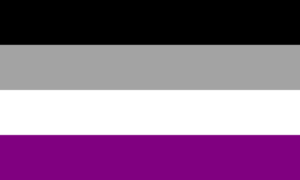
In 2010 the asexual community also created their own flag. Before their flag, they commonly used the ace of spade as their symbol of representation. The flag was given four colors. Black for asexuality, gray for gray-asexuality and demisexual, white for non-asexual partners and allies, and purple for community. (Although later the demisexual community created their own flag).
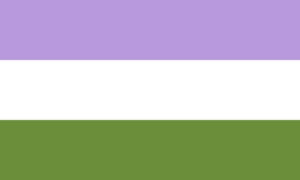 In 2012 Marilyn Roxie design the genderqueer flag. This flag has three colors. Lavender is meant to represent androgynes and androgyny, Roxie also pointed out that lavender is a color that’s “long been associated with queerness”. White is meant to represent agender and gender-neutral folks. Chartreuse green is the inverse of lavender, this stripe is meant to represent people with identities “defined outside of and without reference to the binary”.
In 2012 Marilyn Roxie design the genderqueer flag. This flag has three colors. Lavender is meant to represent androgynes and androgyny, Roxie also pointed out that lavender is a color that’s “long been associated with queerness”. White is meant to represent agender and gender-neutral folks. Chartreuse green is the inverse of lavender, this stripe is meant to represent people with identities “defined outside of and without reference to the binary”.
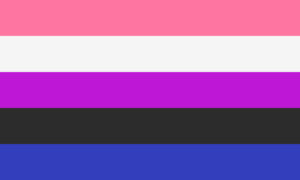
In 2012 the Genderfluid Pride Flag was created by JJ Poole. This flag consists of five horizontal strips to represent gender. Pink represents femininity, Lack of gender = white, Both masculinity & femininity = purple, All genders = black, Masculinity = blue. The Genderqueer Flag, designed by Marilyn Roxie in 2011 includes the color lavender to represent androgyny/ queer identities, white to represent agender identities, and green to represent outside the binary.
Created in 2014 the Non-Binary flag was created by Kyle Rowan at just 17 years old for those who didn’t feel represented by the existing genderqueer pride flag. The flag has four colors. Yellow is for people who identify outside of the cisgender binary of male or female. White is for multigender people. Purple is for people who identify as a blend of male and female genders. Black is for people who are agender or genderless.
 Although there have been a few different Lesbian flags, the first was created in 1999 titled the labrys lesbian flag, and created by graphic designer Sean Campbell. But the flag we know most commonly today was created in 2010 as the term “lipstick lesbian” (met with much controversy) came into popularity. This flag had darker pink, white, and red stripes. The new lesbian flag, (originally made up of seven stripes but later voted down to five), was posted to Tumblr in 2018 by blogger Emily Gwen. The stripes, from top to bottom, represent ‘gender non-conformity (dark orange), ‘independence’ (orange), ‘community’ (light orange), ‘unique relationships to womanhood’ (white) , ‘serenity and peace’ (pink), ‘love and sex’ (dusty pink), and ‘femininity’ (dark rose).
Although there have been a few different Lesbian flags, the first was created in 1999 titled the labrys lesbian flag, and created by graphic designer Sean Campbell. But the flag we know most commonly today was created in 2010 as the term “lipstick lesbian” (met with much controversy) came into popularity. This flag had darker pink, white, and red stripes. The new lesbian flag, (originally made up of seven stripes but later voted down to five), was posted to Tumblr in 2018 by blogger Emily Gwen. The stripes, from top to bottom, represent ‘gender non-conformity (dark orange), ‘independence’ (orange), ‘community’ (light orange), ‘unique relationships to womanhood’ (white) , ‘serenity and peace’ (pink), ‘love and sex’ (dusty pink), and ‘femininity’ (dark rose).
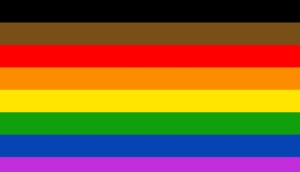 In 2017 the Philadelphia Pride Flag was created including black and brown stripes to the Traditional Gay Pride Flag to symbolize people of color. This flag made its first appearance on June 8, 2017.
In 2017 the Philadelphia Pride Flag was created including black and brown stripes to the Traditional Gay Pride Flag to symbolize people of color. This flag made its first appearance on June 8, 2017.
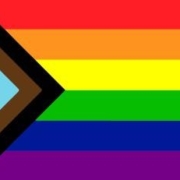
In 2018, designer Daniel Quasar created the “Progress Flag” which is a more inclusive version, the Progress Pride Flag includes white, pink, and light blue striped chevron designs. Pink and light blue represent the traditional colors associated with baby girls and boys while white represents those who are intersex, transitioning, or non-binary. Black and brown stripes represent both people of color and those who are lost due to AIDS.
There are many more Flags still being made today such as the Polyamory Pride Flag, the aromantic pride flag, and the Intersex Pride Flags to name a few.
Additional flags to represent specific subcultures such as the Leather Pride Flag, Rubber Pride Flag were created as well as specific flags representative of sexual or romantic attractions such as the Polysexual and Aromantic Flags. Pride flags that represent communities such as the Straight Ally Pride Flag, Demisexual Pride Flag, and Two-Spirit Pride Flag were also created.
The flag is a beautiful representation of pride and identities within the LGBTQIA+ communities. At CARE Counseling, we pride ourselves on being an LGBTQ+ ally, where all are welcome. We enjoy all lgbtq flags.
If you are a member of the LGBTQIA+ community and often feel stressed, anxious, or depressed, you are not alone. Our clinicians understand that your experiences are important and that intersectionality can affect your experience in therapy. This year, CARE is excited to be a proud sponsor of Twin Cities Pride. We will be there with LGBTQ flags in hand.
We would love to meet you!
You can also schedule an appointment with an LGBTQIA-friendly counselor here.
Some other great resources on our site can be found here:
Coming out as part of the LGBTQ+ community
Written by: Charlotte Johnson, MA, LPCC
We’re Here to help
Our wellness experts will be happy to take care of you. You can CLICK HERE to schedule an appointment now or call (612)223-8898.
Meet Clinicians
We’re united by our commitment to providing effective, relevant, and innovative mental health support at all stages of your journey. Click Here to find out more about who we are, where we come from, and how we live out CARE’s mission every day.
The professionals at CARE are actively collecting and creating resources to help with what you need. We’re Here for You.



